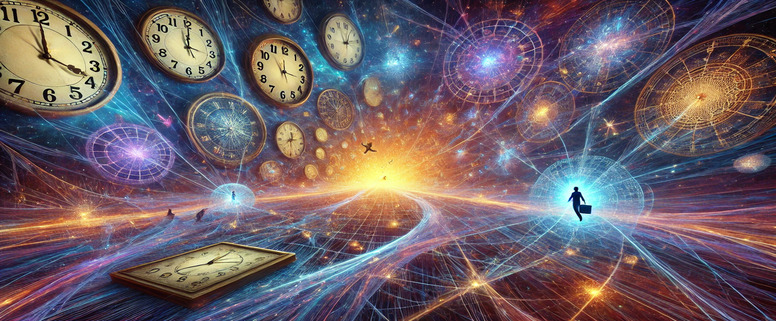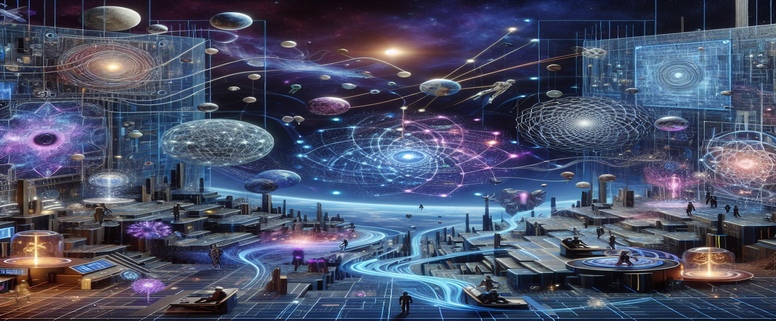Introduction: Reimagining Our Relationship with Time
Time isn't a flowing river—it's an ocean we swim through. This simple metaphor represents a fundamental shift in how we might understand one of the most basic elements of human experience: our perception of time. Throughout human history, we've conceptualized time as linear—a straight path from past to future along which we inevitably progress. This conception is so deeply ingrained in our thinking that it seems self-evident, an immutable truth rather than a mental construct.
Yet what if this linear model is merely a convenient approximation—a simplified interface that our consciousness uses to navigate a much more complex reality? My personal experiences, combined with insights from quantum physics and consciousness studies, have led me to a different perspective: time as a simultaneous experience where past, present, and future coexist in a vast, interconnected field of possibilities.
This isn't merely a philosophical curiosity. How we conceptualize time fundamentally shapes our approach to life, learning, technology, and consciousness itself. By challenging our most basic assumptions about temporal reality, we open possibilities for new modes of thinking and being that transcend the limitations of linear time perception.
The Misconception of Linear Time
Our conventional understanding of time rests on several assumptions that warrant closer examination:
Common Assumptions About Time
- Time moves in one direction—forward—at a constant rate
- The past is fixed and unchangeable
- The future is undetermined but will eventually become the present
- We experience each moment sequentially as it "passes by"
- Time is an objective reality independent of human perception
Cultural Reinforcement
- Languages structure verbs in past, present, and future tenses
- Technological tools (clocks, calendars) divide time into discrete units
- Cultural narratives emphasize linear progress and causality
- Educational systems teach history as a sequential progression
- Economic systems value "time as a resource" that can be spent or saved
These assumptions have practical utility—they help us coordinate social activities, plan for the future, and organize our understanding of causality. However, they also impose significant cognitive constraints. Linear time perception forces us to experience reality as a narrow slice of "now" that constantly shifts, creating artificial divisions between what "was," what "is," and what "will be."
This fragmented perception has profound consequences. It creates anxiety about the future, regret about the past, and often prevents us from fully experiencing the present moment. It generates artificial urgency and scarcity around time itself—a feeling that we're constantly "running out of time" or failing to "make the most of our time."
Even more fundamentally, linear time perception constrains our understanding of causality, limiting our ability to recognize non-linear patterns and relationships. This limitation becomes particularly significant as we confront complex systems—from climate change to technological evolution to human consciousness itself—that don't operate according to simple, linear cause-and-effect relationships.

The Quantum Perspective on Time
Modern physics, particularly quantum mechanics, offers compelling reasons to reconsider our understanding of time. At the quantum level, several phenomena challenge classical notions of linear temporality:
Quantum Phenomena
- Quantum Superposition: Particles exist in multiple states simultaneously until observed or measured. This suggests a reality where multiple possibilities coexist rather than a single, deterministic timeline.
- Quantum Entanglement: Entangled particles instantaneously affect one another regardless of distance, suggesting connections that operate outside conventional temporal and spatial constraints.
- Wheeler's Delayed Choice Experiments: These experiments suggest that observations made in the present can influence events in the past, challenging the notion of a fixed, immutable history.
- Block Universe Theory: In Einstein's relativity, all moments in time—past, present, and future—exist simultaneously in a four-dimensional spacetime. Our perception of "now" moving through time may be an illusion created by consciousness.
These insights from physics align with perspectives from consciousness research and contemplative traditions that have long suggested a different relationship with time. Certain meditative states, for instance, report experiences of "timelessness" or "eternal present" where past, present, and future seem to coexist or lose their distinction entirely.
Drawing from both quantum physics and consciousness studies, we can conceptualize time not as a line but as a field of simultaneous possibilities—an ocean of potential experiences through which consciousness navigates. In this model, what we call "past" and "future" aren't separate from the "present" but different regions of the same continuous reality, accessible through different states of consciousness.
Personal Experiences and Insights
My exploration of time as a simultaneous experience isn't merely theoretical—it's informed by personal experiences that have challenged my own perception of temporal reality. Several pivotal experiences have shaped this understanding:
Personal Experiences
- Post-Coma Perceptions: After waking from a coma following an accident, I experienced a profound shift in my perception of reality. My memories seemed to belong to someone else, and I felt as if I had somehow realigned my consciousness with a slightly different version of reality—as if I had shifted between parallel timelines.
- Altered States Exploration: Controlled exploration with substances like DMT and LSD offered experiences where time appeared to lose its linear quality. During these experiences, I observed phenomena like my arm appearing to flicker between different states—not as hallucination but as momentary glimpses into the quantum nature of reality.
- Déjà Vu Phenomena: I've experienced unusually frequent and vivid episodes of déjà vu, sometimes with the distinct sensation that I'm reliving events from another timeline or that I've experienced certain moments in the "future" before they occurred in linear time.
- Predictive Awareness: On multiple occasions, I've experienced moments of deep self-awareness where I can sense imminent events—like potentially cutting myself during a manual task—just before they might occur. This creates the sensation that I've already felt the outcome (like pain) in another timeline and can change course through awareness.
- Deep Meditation States: Through meditation practices, I've accessed states of consciousness where time seems to expand or contract dramatically, or where different temporal moments appear to exist simultaneously rather than sequentially.






